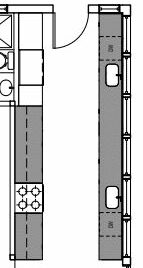Introduction: A Client’s Guide to Architectural Drawings
We will use the Air Jordan model XXXI to teach you how to understand the four basic architectural drawings so that you can know what makes up your construction project. The architectural plan drawing offers a bird’s-eye view of a space. Four additional views provide more information regarding your space.
Pro-Tip: Technical drawing, drafting, or drawing all refer to the same thing and visually communicate how something functions or is constructed.


Roof Plans
Roof plans offer a bird’s eye view of a structure, in this case, a home. Roof plans specify the roofing material, the intersecting components, and surrounding areas, such as the deck, patio, or the ground below. Roof plans are required if there is construction to change an aspect of the roof.
Plans
The starting place for navigating spaces are plans, also called floor plans, which summarize the information about a room.. Plans are drawn from a downward angle to show how the rooms relate to one another. The walls are “cut” at 5’ above the floor to capture the wall thickness, windows, door openings, cabinetry, plumbing, and appliances. Furniture and floor finishes can also be shown in the plans.
Pro-Tip: The plan’s north direction is to the top of the plan sheet, or the left.
Pro-Tip: Architects and designers separate different types of information onto different plans for clarity.


Plan Detail and Detail Plans
A Detail Plan is of a larger scale than the above Plan. The zoomed-in view allows more information on a particular area or room to be more clearly communicated.


Elevation Drawings
Elevation drawings illustrate the vertical surfaces of a space. The same elements from the plan view are presented from the front. Elevations depict the arrangement of the features on one wall. The scale usually matches the scale of the Detail Plans.
Pro-Tip: The heavier lines around the edge of the drawing view indicate that a wall, floor, or ceiling are cut lines.


Section Drawings
Section drawings are an MRI scan of a building. A section view slices vertically through the walls and floors to show how the construction materials connect, and how the areas relate spatially.


Section Details
Section details are the enlargement of a particular part of the section drawing. The close-up view provides more information about the construction assembly.
Details
Detail drawings zoom in so close that you can see the pores and follicles of a building. The architect uses these drawings to show how the parts fit together, clarifying materials and relationships. These details may be specific to your project, industry standards or code requirements, or assemblies proprietary to your architect to achieve their level of design quality.


Three-Dimensional Drawings
3D line drawings are essential to the drawing set. These are line drawings that do not capture every detail; instead, they convey complex spatial relationships hidden in the two-dimensional plan, section, and elevation views. In addition, 3D drawings are very effective in bringing you, the client, into the project.


Review: Plan, Elevation, Sections + Details, and 3D Drawings
- Plans are horizontal views – you look down at the ground.
- Elevation and Section are vertical – you are looking straight ahead.
- Plans and Sections focus on the vertical “cut” – the MRI view.
- Elevations illustrate the flat vertical planes.
- Details = zoom
- 3D = a line drawing version of a photograph
Summary: Plans, Sections, Elevations, and Detail Drawings: Their Definition & Purpose
| Air Jordan Images | Drawing Name | Where are you looking? | Purpose | Apt drawings |
 | Plans | Plans are a flat view looking from above or below. | Plans show how rooms are related to each other spatially. |  |
 | Plan Detail and Detail Plans | Detail Plans are a zoomed-in flat view, also looking from above. | Detail Plans show more in-depth information about what is in that area. |  |
 | Elevations | Elevations are flat views of a wall, as though you are looking straight ahead. | Elevations show the heights of objects and where they are in relationship to each other on a wall. |  |
 | Sections, or Cross-sections | Sections are flat views that cut space like an MRI creates images of a body. Cross-sections refer to full-building Sections. | Sections reveal how the rooms and or materials fit together. |  |
 | Details | Flat view closeups. | Details show how materials fit together. |  |
 | 3D views BONUS! | Three-dimensional view of spatial relationships. | 3D views illustrate complex spatial relationships. |  |
Moving Forward: How Will You Use Your Knowledge About Different Types Of Architectural Drawing?
You will know the purposes for the main architectural drawing types and will understand your project better. You will be more aware of the design ideas, have the vocabulary to ask for the information you want!
IMAGE SOURCES:
http://jordansdaily.com/2017/05/06/air-jordan-31-not-gets-cut-half-ripped-torn-apart/
Do you have questions about Architectural Drawings Explained? Contact us, and we may include the answer in a future article!
At AKA, we specialize in transforming homes to increase light views and space; we focus on our clients’ delight!
Help yourself by reading our insights and by asking us your questions
Want more information? We will be writing more about all of these subjects; if you want them in your inbox as soon as we post them, sign up here.

Allegra Kochman
About the Author
Allegra has a BA with Honors from Dartmouth College and a Master of Architecture from Columbia University. She aims to write straightforward and practical content for those who want to gut renovate their homes.

